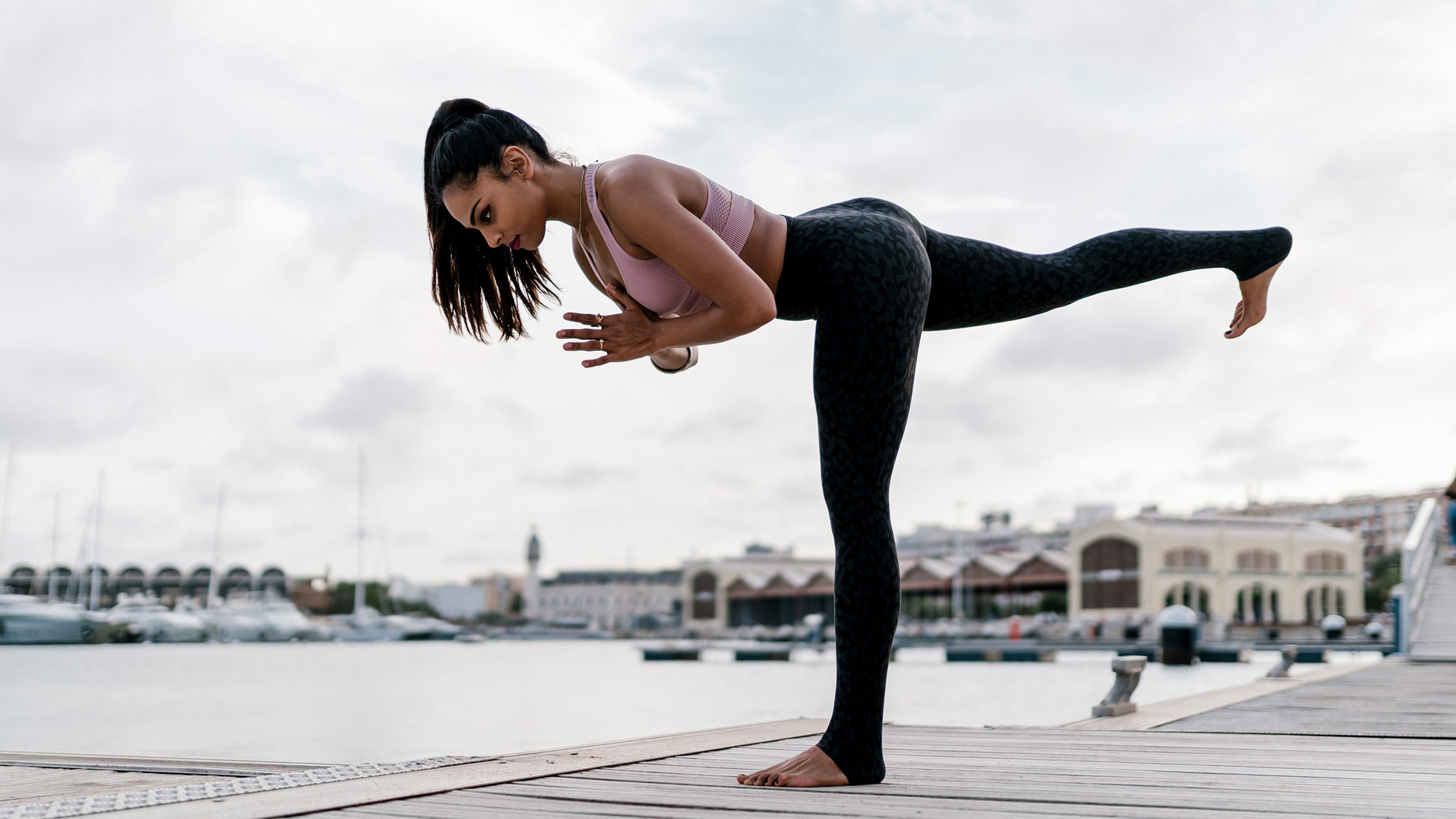
One of the most basic yoga poses for beginners is the standing leg raise. Standing with your feet together, place your arms straight out in front of you. Look up with one hand towards the sky. Hold both hands at shoulder-width apart. This position is good for your back, legs, and hamstrings. Additionally, it can tone your legs and build core strength. You should practice this posture for about six to eight times before you're able to perform it properly.
The staff pose is a seated version the mountain pose. It helps beginners to learn the proper alignment principles for the seated positions. Engage your leg muscles, lift your chest, and relax your shoulders to complete this asana. This will allow for you to relax your shoulders which will result in a gentle bend of your knee. A prop can be placed on top of your knees to modify the position.
The downward-facing-dog pose is a great way to end a yoga session. This is a great pose to get started if your first yoga session is not over yet. You should keep your hips elevated and extend your heels towards the floor. While you don't need your heels to touch the floor it will stretch your outer hips. For a more comfortable experience, bend your knees so your hips remain parallel.

The corpse poses is a great choice for transition poses. While it can be challenging to get your body to a relaxed state at first, it becomes easier over time. You can get the most from your yoga practice by giving yourself ample time and taking a few minutes every day to review your posture. As your practice progresses, you will see both physical and mental benefits. The benefits of a daily yoga practice are immense.
For beginners, the triangle pose is one that's most common. It strengthens the chest muscles and hamstrings. It is a good starting point in any yoga practice. Seated Spinal Twist: This is another popular beginner yoga pose. This stretch helps strengthen the legs while strengthening the spine and upper back. This is a great way to strengthen your back.
The twist pose can be a great introduction to twists in yoga. The twists are good for lengthening the bottom leg, and counteracting back tension. While this pose might be difficult for someone with back pain, it can strengthen your back and help you strengthen your legs. This is an excellent exercise for beginners. Try the child's pose to help you get started if you don't know where to start. Once you are familiar with the cat, it will be easy to perform the pose in any position.
A good starting pose is the forward bend. It's a full-body stretch that strengthens the hamstrings as well as the calves. You should concentrate on the bridge pose, which is a beginner yoga pose, during your yoga session. It will increase your balance and flexibility. It can be difficult if your are not familiar with basic yoga. But you will be able to do this pose with the support of a teacher.

Beginners should learn to do the child's position. This will give you a solid base of strength, and help improve your body alignment. Many of the poses in yoga for beginners can be used together. You should start with the basic poses to build your way up to more advanced ones. Practice! Don't forget to practice these poses even if you are a beginner. You can modify them to your liking.
The popular yoga pose for beginners is the downward dog. The intention of this pose is to strengthen the spine. Stretching your thighs, shoulders and chest will make this position easier. Bend your arms to the sides, then release them. It's important to stay in the pose for at least thirty seconds. To improve your movements, you may also want to try other versions. Then, practice the poses for beginners until you master them all.
FAQ
Which dietary supplements are good for weight loss.
Weight loss requires diet and exercise. However, some people find that certain supplements help them along the way.
Some studies suggest that omega-3 fatty acids may help with weight loss. Omega-3s are essential fats that are important for brain function and cell membrane integrity. They are found in fish like salmon, tuna, shrimp and cod liver oil.
Some research has shown that green tea could be helpful in weight loss. Green tea is rich in catechins, antioxidants which may boost metabolism and aid weight loss.
Can I go to the gym 7 days a week?
You can go to your gym seven days a semaine, but not simultaneously. You must find a time you can do it without feeling exhausted and depleted.
This will keep you motivated and provide energy for other activities.
You must also ensure that you eat enough during these times. This will make it so you don't feel tired or sluggish while going to the gym.
Last but not least, ensure there are no other people competing for your time. For example, if you have children, you may want to avoid exercising on school nights as they will distract you from your workout.
Is cardio exercise good for your health or bad?
Cardiovascular exercise offers many benefits. It improves blood flow, strengthens your heart muscle and increases stamina.
Cardiovascular exercise includes running, biking, hiking, swimming, tennis, basketball, soccer, volleyball, football, etc.
It is important to keep in mind that cardio exercises should not only be performed at a high level of intensity, but also at low levels. This could result in injury.
If you feel fine, only do the cardiovascular exercise.
It is important not to push yourself beyond your limits. If you do, you might injure your self.
When you engage in cardiovascular exercise, it is best to warm up first. Next, increase your intensity gradually.
You must always listen to what your body is telling you. You should stop immediately if you feel any pain while doing cardiovascular exercise.
It is also recommended to take some time off after a cardiovascular exercise. This will give your muscles time for recovery.
Cardiovascular exercise is essential for losing weight.
It is the best method to lose calories and reduce belly weight.
How many calories should I consume daily?
This can vary from person to person. The average is 2000 - 2500 calories per day. It is important to consider your lifestyle and determine how many calories you'll need.
Do I have to exercise while drinking alcohol?
Yes. Alcohol can increase energy expenditure and speed up recovery, as well as reduce soreness.
Alcohol also increases insulin sensitivity, making it easier to absorb glucose.
Dehydration can result from alcohol, which can affect your metabolism. It also reduces testosterone production, which may decrease muscle-building potential.
It is important that women refrain from drinking alcohol before they exercise. Women who are heavily alcoholic should wait at minimum 24 hours before starting to work out.
Women who are nursing should avoid alcohol as much as possible.
Men should limit their alcohol intake to just one drink each day.
What is a good seven-day workout routine?
A seven-day exercise plan should include cardiovascular training (running/biking/swimming), strength exercises (using weight machines, free weights) and one flexibility/core program (yoga or Pilates). It's essential to do each activity at least once a week. Each session should not take more than 45 mins.
Cardiovascular Exercises: Running, biking, swimming
Your goal is to exercise at least 60 minutes each week. Aim for 75 minutes per week to get the best results. Cardio exercise can improve blood flow and stimulate muscle development.
Strength Training
Cardio exercises focus on the heart and lungs while strength training targets muscles and bones. Strength training can help you burn calories even when you're not working out.
Flexibility and Core Workouts
You can strengthen your entire body by strengthening flexibility and core exercises. Yoga and Pilates are both excellent choices.
Statistics
- Cardmembers earn 5% Back at Amazon.com with a Prime Credit Card. (amazon.com)
- Candidates and applicants must pass all four tests at 70% (minimum level) to graduate from Basic Deputy U.S. Marshal (BDUSM) Training. (usmarshals.gov)
- The PRS enabled risk stratification for overall prostate cancer and lethal disease with a four-fold difference between men in the highest and lowest quartiles (HR, 4.32; 95% confidence interval [CI], 3.16-5.89). (pubmed.ncbi.nlm.nih.gov)
- 10 pounds in a month is likely during a lean bulking phase, especially for beginners. (muscleandstrength.com)
- An estimated calorie range for moderately active adult males falls between 2,200 to 2,800 calories per day, depending on age. (eatright.org)
External Links
How To
What nutrients do men need each day?
Men require daily nutrition for healthy growth and development. The body requires vitamins and minerals, protein, carbohydrates, fats (fats), water, fiber, as well other essential elements.
Males also require specific nutrients at certain times of the day. For example, when you sleep, your body uses energy from food to make hormones, antibodies, and enzymes. You use protein to build muscles and repair damaged tissue when you wake up.
Your body burns fat at night and stores it as energy as glycogen. Your body still requires sufficient nutrients and calories even though it needs less calories. You might have an occasional snack during the night if your stomach is feeling hungry.
When you work out, you need adequate levels of carbs and protein to fuel your muscles. You may feel sore muscles if you exercise hard.
To prevent this from happening, you need to consume carbs or protein within two hours. To get energy from glucose, your body will start to degrade stored glycogen.
Additionally, it is important to eat protein right away after your workouts are over. This prevents muscle tissue loss that happens while you sleep.
Your body produces lactic acid during high levels of physical activity. It builds up in your bloodstream, which can lead to fatigue. To avoid this, you should eat foods rich in carbohydrates, such as fruits and vegetables.
Carbohydrates can give your body the energy it requires to recover from intense exercise.
In addition, you may want to include lean meats, fish, eggs, milk, cheese, yogurt, beans, nuts, and seeds into your diet.
All of these foods contain high quality protein. Protein helps to repair and grow muscles. It provides amino acids that your body needs in order to produce sexhormones and testosterone.
Good skin, hair, and joint health requires adequate dietary fats. Healthy men need between 20% - 35% of the total caloric intake to be fat.
Fat is good for your heart and helps you fight cancer. It keeps your brain healthy and functioning well.
Vegetable oils, such as olive oil, sunflower oil or corn oil, soybean oil and peanut oil, can supply most of the fats you require.
These oils have high amounts of monounsaturated oil fatty acids, (MUFAs). MUFAs are good for lowering cholesterol and reducing inflammation. They protect your cells against free radical damage.
Saturated oils (SFAs), found primarily in animal products such meats, dairy products and butter, are known to raise LDL ("bad") cholesterol. SFAs increase LDL ("bad") cholesterol, and increase triglycerides. They are also good for weight loss and belly fat.
Polyunsaturated oils (PUFAs), are found in plant-based foods like nuts, seeds and vegetable oils. PUFAs reduce inflammation and improve cardiovascular function. They help to control blood sugars and cholesterol.
Erectile dysfunction is common in men with low HDL ("good") cholesterol. Consuming high amounts of saturated fats can increase bad cholesterol and lower good cholesterol.
Men who eat large quantities of red meats or pork may develop prostate problems. High temperatures can cause nitrates to become nitrosamines. These compounds can cause cancer.
Most processed meats contain nitrites or other harmful chemicals. Avoid them completely.
The American Heart Association recommends limiting red meat intake to two meals per week. Choose poultry, fish and legumes instead.